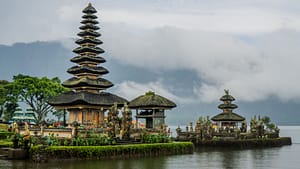Bemo
Bemos are normally a minibus or van with a row of low seats down each side and which carry about 12 people in very cramped conditions. They were once the dominant form of public transport in Bali, but widespread motorbike ownership (which is often cheaper than daily bemo use) has caused the system to wither. Expect to find that getting to many places by bemo is both time-consuming and inconvenient. It’s uncommon to see visitors on bemos in Bali.
Bicycle
Increasingly, people are touring the island by sepeda (bike) and many visitors are using bikes around towns and for day trips. There are plenty of bicycles for rent in tourist areas, but many are in poor condition. Ask at your accommodation. Prices are from 30,000Rp per day.
Boat
Fast boats linking Bali, Nusa Lembongan, Lombok and the Gili Islands have proliferated, especially as the latter places have become more popular.
Bus
Distances in Bali are relatively short, so you won’t have cause to ride on many large buses unless you are transferring between islands or going from one side to another. Larger minibuses and full-size buses ply the longer routes, particularly on routes linking Denpasar, Singaraja and Gilimanuk. They operate out of the same terminals as bemos. However, with everybody riding motorbikes, there are long delays waiting for buses to fill up at terminals before departing.
Trans-Sarbagita Bus
Trans-Sarbagita runs large, air-con commuter buses like you find in major cities the world over. It is suited more to locals due to long wait times and unreliable schedules; however, it’s handy if you’re heading along any of the following four routes: the bypass linking Sanur to Nusa Dua; Denpasar to Jimbaran; Tabanan to Bandara; or Mahendradata to Lebih via Sanur.
Tourist Bus
Tourist buses are economical and convenient ways to get around. You’ll see signs offering services in major tourist areas. Typically a tourist bus is an eight- to 20-passenger vehicle. Service is not as quick as with your own car and driver but it’s far easier than trying for public bemos and buses.
Kura-Kura Bus
This innovative expat-owned tourist-bus service covers important areas of south Bali and Ubud. Buses have wi-fi and run during daylight and early evening, from every 20 minutes to over two hours. Check schedules online or with the app. There are eight lines and the hub is the DFS Galleria duty-free mall.
Car & Motorcycle
Renting a car or motorbike can open up Bali for exploration – and can also leave you counting the minutes until you return it; there can be harrowing driving conditions on the islands at certain times and south Bali traffic is often awful. But it gives you the freedom to explore myriad back roads and lets you set your own schedule.
Dokar
Small dokar (pony carts) are still seen in parts of Denpasar and Kuta, but they’re uncommon. Treatment of the horses is a major concern and there is no good reason to go for an expensive tourist ride.
Ojek
Around towns and along roads, you can always get a lift by ojek (a motorcycle or motorbike that takes a paying passenger). Formal ojek are less common now that anyone with a motorbike can be a freelance ojek (stand by the side of the road, look like you need a ride and people will stop and offer). They’re OK on quiet country roads, but a risky option in the big towns. Ojek are more common on Lombok.
Taxi
Metered taxis are common in south Bali and Denpasar (but not Ubud). They are essential for getting around and you can usually flag one down in busy areas. They’re often a lot less hassle than haggling with drivers offering ‘transport!’

